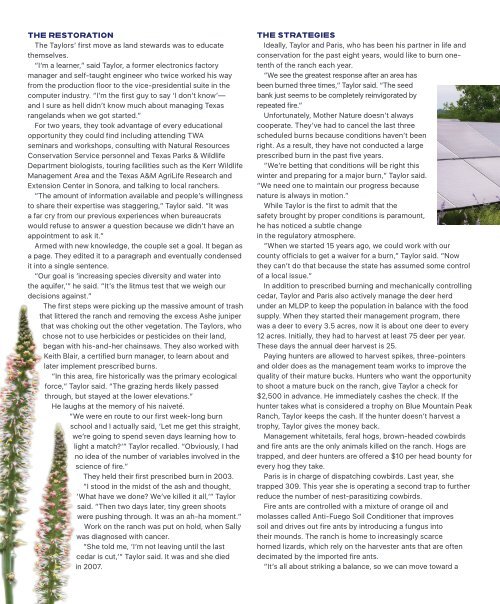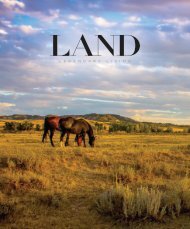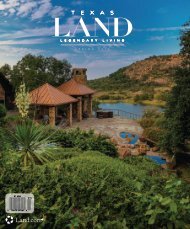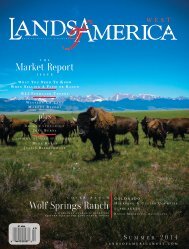You also want an ePaper? Increase the reach of your titles
YUMPU automatically turns print PDFs into web optimized ePapers that Google loves.
THE RESTORATION<br />
The Taylors’ first move as land stewards was to educate<br />
themselves.<br />
“I’m a learner,” said Taylor, a former electronics factory<br />
manager and self-taught engineer who twice worked his way<br />
from the production floor to the vice-presidential suite in the<br />
computer industry. “I’m the first guy to say ‘I don’t know’—<br />
and I sure as hell didn’t know much about managing Texas<br />
rangelands when we got started.”<br />
For two years, they took advantage of every educational<br />
opportunity they could find including attending TWA<br />
seminars and workshops, consulting with Natural Resources<br />
Conservation Service personnel and Texas Parks & Wildlife<br />
Department biologists, touring facilities such as the Kerr Wildlife<br />
Management Area and the Texas A&M AgriLife Research and<br />
Extension Center in Sonora, and talking to local ranchers.<br />
“The amount of information available and people’s willingness<br />
to share their expertise was staggering,” Taylor said. “It was<br />
a far cry from our previous experiences when bureaucrats<br />
would refuse to answer a question because we didn’t have an<br />
appointment to ask it.”<br />
Armed with new knowledge, the couple set a goal. It began as<br />
a page. They edited it to a paragraph and eventually condensed<br />
it into a single sentence.<br />
“Our goal is ‘increasing species diversity and water into<br />
the aquifer,’” he said. “It’s the litmus test that we weigh our<br />
decisions against.”<br />
The first steps were picking up the massive amount of trash<br />
that littered the ranch and removing the excess Ashe juniper<br />
that was choking out the other vegetation. The Taylors, who<br />
chose not to use herbicides or pesticides on their land,<br />
began with his-and-her chainsaws. They also worked with<br />
Keith Blair, a certified burn manager, to learn about and<br />
later implement prescribed burns.<br />
“In this area, fire historically was the primary ecological<br />
force,” Taylor said. “The grazing herds likely passed<br />
through, but stayed at the lower elevations.”<br />
He laughs at the memory of his naiveté.<br />
“We were en route to our first week-long burn<br />
school and I actually said, ‘Let me get this straight,<br />
we’re going to spend seven days learning how to<br />
light a match?’” Taylor recalled. “Obviously, I had<br />
no idea of the number of variables involved in the<br />
science of fire.”<br />
They held their first prescribed burn in 2003.<br />
“I stood in the midst of the ash and thought,<br />
‘What have we done? We’ve killed it all,’” Taylor<br />
said. “Then two days later, tiny green shoots<br />
were pushing through. It was an ah-ha moment.”<br />
Work on the ranch was put on hold, when Sally<br />
was diagnosed with cancer.<br />
“She told me, ‘I’m not leaving until the last<br />
cedar is cut,’” Taylor said. It was and she died<br />
in 2007.<br />
THE STRATEGIES<br />
Ideally, Taylor and Paris, who has been his partner in life and<br />
conservation for the past eight years, would like to burn onetenth<br />
of the ranch each year.<br />
“We see the greatest response after an area has<br />
been burned three times,” Taylor said. “The seed<br />
bank just seems to be completely reinvigorated by<br />
repeated fire.”<br />
Unfortunately, Mother Nature doesn’t always<br />
cooperate. They’ve had to cancel the last three<br />
scheduled burns because conditions haven’t been<br />
right. As a result, they have not conducted a large<br />
prescribed burn in the past five years.<br />
“We’re betting that conditions will be right this<br />
winter and preparing for a major burn,” Taylor said.<br />
“We need one to maintain our progress because<br />
nature is always in motion.”<br />
While Taylor is the first to admit that the<br />
safety brought by proper conditions is paramount,<br />
he has noticed a subtle change<br />
in the regulatory atmosphere.<br />
“When we started 15 years ago, we could work with our<br />
county officials to get a waiver for a burn,” Taylor said. “Now<br />
they can’t do that because the state has assumed some control<br />
of a local issue.”<br />
In addition to prescribed burning and mechanically controlling<br />
cedar, Taylor and Paris also actively manage the deer herd<br />
under an MLDP to keep the population in balance with the food<br />
supply. When they started their management program, there<br />
was a deer to every 3.5 acres, now it is about one deer to every<br />
12 acres. Initially, they had to harvest at least 75 deer per year.<br />
These days the annual deer harvest is 25.<br />
Paying hunters are allowed to harvest spikes, three-pointers<br />
and older does as the management team works to improve the<br />
quality of their mature bucks. Hunters who want the opportunity<br />
to shoot a mature buck on the ranch, give Taylor a check for<br />
$2,500 in advance. He immediately cashes the check. If the<br />
hunter takes what is considered a trophy on Blue Mountain Peak<br />
Ranch, Taylor keeps the cash. If the hunter doesn’t harvest a<br />
trophy, Taylor gives the money back.<br />
Management whitetails, feral hogs, brown-headed cowbirds<br />
and fire ants are the only animals killed on the ranch. Hogs are<br />
trapped, and deer hunters are offered a $10 per head bounty for<br />
every hog they take.<br />
Paris is in charge of dispatching cowbirds. Last year, she<br />
trapped 309. This year she is operating a second trap to further<br />
reduce the number of nest-parasitizing cowbirds.<br />
Fire ants are controlled with a mixture of orange oil and<br />
molasses called Anti-Fuego Soil Conditioner that improves<br />
soil and drives out fire ants by introducing a fungus into<br />
their mounds. The ranch is home to increasingly scarce<br />
horned lizards, which rely on the harvester ants that are often<br />
decimated by the imported fire ants.<br />
“It’s all about striking a balance, so we can move toward a
















